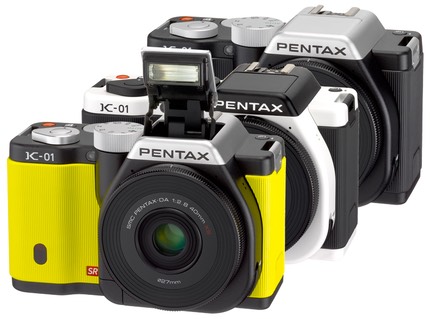Japan's big camera trade show, CP+, will be opening soon, and because of last year's quake, tsunami, and flood, we've got a few extra products in the queue for show announcements this year.
First up is Ricoh/Pentax, which introduced their new K-01 mirrorless camera and a new lensor for the existing GXR mirrorless camera.

Photo supplied by Pentax and used with permission
The K-01 is the first of the mirrorless cameras to not take advantage of the missing mirror to reduce the depth of the camera. That's right, it's basically a DSLR without a mirror or viewfinder, and that means it can use any existing K-mount lens without adapter. That's a strong incentive for the K-mount enthusiasts, to be sure, but the problem is that you get no large size/weight reduction this way. To compensate, Pentax is ramping up the pancake lens production, and is introducing the camera with what they call the thinnest interchangeable lens, the new DA 40mm f/2.8 XS. Even so, this is still neckstrap camera, not a big pocket camera as many of the mirrorless forerunners have turned out to be.
I've added the Pentax K-01 and its new lens to the Camera Database section of the site, but the relevant details you're probably looking for are: 16mp, 6 fps, contrast AF (manual focus with peaking), 3" 921k dot display (no EVF or EVF option), pop-up flash, strong video capabilities, and a rather simple user interface. Body only is US$750. The 40mm lens is US$250 (US$100 discount if bought with body).
The lack of EVF is, to me, the turn off. Big cameras being framed via a fixed LCD at arms length are problematic, in my experience, even with image stabilization. At 19 ounces without lens, the K-01 is fairly heavy, so extended shooting might get a bit taxing.
Pentax made a big deal about using a well-known designer, Mark Newson, but it seems that the main result of that is a modern, boxy shape incorporating Newson's trademark colors (black, white, yellow). At least the camera has a grip and immediately understandable controls.
Overall, though, the K-01 is a welcome addition and one that has unique aspects that extends the mirrorless market further into the low-end DSLR line. If you've got K-mount lenses, the K-01 is worth a close look.
Ricoh/Pentax also had a new offering on the Ricoh side of their camera operations (how long are we going to get two brand names from one company?): the long-expected APS-C zoom lensor for the GXR has finally made its appearance. This 16mp APS sized module comes with a 15.7-55.5mm f/3.5-5.5 zoom lens (24-85mm equivalent). One surprise: ISO only up to 3200.
While this new lensor is a welcome option for us GXR users, it really doesn't push us very far and it reiterates the problem of bundling sensor with lens. We've been using a 28mm and 50mm 12mp APS module. Ricoh now gives us a slower lens that reaches a bit further at the two ends we previously had (24 instead of 28, 85 instead of 50) plus a newer, better sensor. That means someone trying to have options in the primary focal length range has now bought three sensors and three lenses, and the sensors don't match in quality/performance, nor can you use your fastest lens on the best sensor. No price or availability was announced. Update: Japanese store pricing just posted would translate to US$700.
Footnote: every now and again photography equipment gets nicknames. For instance, the Nikkor 28-70mm f/2.8 is The Beast, while the Sigma 50-500mm is The Bigma. The Canon 100-400mm is The Dust Trombone. Well, it seems that the K-01 already has garnered a nickname for the yellow version: The Tonka. Personally, I think they're a little more Lego-like than Tonka-like, but I get it.
